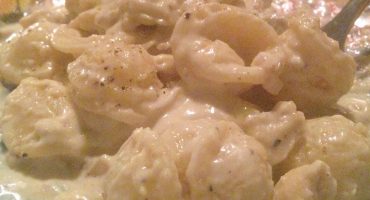
Extreme Simmer: The SousVide Supreme
So after hearing me bitch for the last two years about how everyone on Top Chef gets to sous vide but I don’t, someone finally decided to throw me a bone. The folks over at SousVide Supreme, the first legit sous vide machine aimed at home cooks, sent me over one of their $450 contraptions to test out for a few weeks. Woo-hoo!
For those who need a recap: sous vide cooking involves vacuum sealing ingredients in plastic bags with this neat little contraption:
That’s actually the most fun part, watching all the air get sucked right out of the bag. Then you submerse the bag in a thermal hot water bath that’s designed to remain at an exact pre-set temperature, down to the degree:
The idea is that you get food cooked perfectly and uniformly every time, and that it retains all of the nutrients and flavor that might be allowed to sneak out when baking, boiling or sauteeing.
First thoughts: sous vide takes a long ass time. I don’t really understand how the Top Chef-testants are always doing this during the quickfire, because at least with this machine, it took about half an hour to heat the bath up to the required temperature (usually 140 degrees for meat and 185 for vegetables), and then between 40 minutes and many, many hours to actually cook the thing.
Instead of making a full meal, our tasting team tried out sous vide-ing a whole bunch of different ingredients to see how this bad boy handles the basics.
The meat was definitely the most successful, notably this nice little lamb tenderloin, which was perfectly, uniformly soft throughout every bite. Even that little edge of fat you see on the left somehow tasted gloriously soft and flavorful — not a hint of chewiness.
Salmon (which I cooked with mustard, dill, salt and pepper added to the bag) was also pretty perfectly cooked, if less revelatory. I think the main sell here with the fish is that it makes it super easy to cook. No worries about dry, overcooked fish or scary, undercooked fish — just set the time and temp designated and it cooks perfectly throughout.
Fruits and veggies we were less impressed with. We sous vide-d up carrots, onions, squash, yucca, beets, pineapple, pears, and blueberries (phew). The carrots were probably the only thing that were noticeably different from any other cooking method. They don’t lose any of that flavor that might otherwise seep into a sauce when cooking, and the sous vide carrots had a more intense flavor than you’d expect. The other fruits and veggies, while cooked well, were underwhelming — our tasting team found no particular difference in flavor or texture that would convince us buy a sous vide machine to make these. Everything was tasty, it just didn’t blow our minds.
Scrambled eggs were fun to make — you just crack the eggs right into the bag, agitate it a few times throughout cooking and voila, you’ve got a creamy scramble that’s been cooked uniformly throughout — with no burnt, crumbly edges. The machine can also be used to hard-boil or poach an egg, but we didn’t try that because, um, it takes at least an hour. Neat that you can set it to make an egg perfectly every single time, but really, what home cook is going to put aside an hour+ of their time to make an egg?
Overall, I’m so far a little underwhelmed by sous vide at home. If I had this machine all the time, I’d definitely break it out once in a while to sous vide a nice piece of meat, but I’m not convinced it’s worth the effort for other foods.
Notably, after the vacuum packing part, it’s just not that fun. This kind of cooking is all about perfection, not experimentation. You just put your food in the machine and wait — no adding ingredients throughout, no filling your kitchen with beautiful smells — no errors, but also no discoveries. One of our more intellectual tasters noted that cooking can be kind of like art or architecture — making something that’s perfectly, uniformly beautiful is perhaps not as interesting as making something that’s got a few flaws in it, if only for the excitement in each new bite. So maybe we do want those different textures and burnt edges after all. OK, so if you buy a $30 filet mignon, you don’t want any burnt edges, but for run-of-the-mill foods, sous vide may not be the panacea Top Chef had led me to believe.
Perhaps I’m being too hard on this little guy — everything we cooked in it was, after all, delicious, just not as life-changing as I was hoping for. We decided sous vide is the Barack Obama of kitchen appliances — it does a perfectly fine job, but really we were expecting miracles.
So what am I missing? I’ve got this bad boy for another week and am way open to suggestions for what else I should drop up in him.



love this post! I’ve been really curious about sous vide. I really like the idea that you don’t lose any nutrients, but excellent point about how the discovery and experimenting aspects of cooking are lost. I think I might like this when I don’t feel like cooking but want a fresh cooked meal. Also, the Barack Obama comparison was perfect!
What about using it for lobster? Throw some butter and a lobster tail in there, I bet that is delicious.
Is it going to be the ‘bread machine’ of the past?
Has SousVide done any testing to determine if any chemicals are leaching into the food from the plastic when it is heated?
I love my food cooked perfectly, but I’d rather is be without any trace chemicals.
I’m willing to be a guinea pig during your experimentation, especially if you use Chad’s suggestion.
In response to Chad, I personally cooked an entire lobster last week. I did however have to separate the claws and cut the tail in half, and cut some of the sharp nubs from the claws, but it vacuum sealed beautifully! I dropped in a dab of butter and a squeeze of lemon. The texture was like nothing I’d ever tasted. It had a tenderness like a moist white fish rather than a chewy texture. I cooked it for 40 minutes at 140 degrees.
In addition, sous vide any cake mix. I used a Betty Crocker Spice cake for my testing. Use the SousVide Supreme as a shallow water bath, bringing the water line up to the level of the cake mix in your loaf pan. Cover with foil so the condensation does not drip into the the cake while cooking. Set your SousVide Supreme at 185F/85C and cook for 90 minutes. Incredibly dense and moist! Depending on the ingredients in the cake, you may vary the temperature 5 degrees on either side. Experiment with it! After all, you have another week!
Also, remember that Sous vide is an alternative way of cooking, not a replacement for other cooking methods, merely a compliment or enhancement if you will. Have fun!
@sushi – good question about the plastic chemicals! I’m curious too.
You should try to sous vide like the biggest thing that fits in the bag. I don’t even know what that would be… but something big.
Like an entire pork shoulder.
Or a watermelon.
what about cookie dough. but don’t cook it long enough where it actually turns into a cookie, just so it heats through and kills any harmful crap. so it could be one gooey, warm, doughy, chocolaty, gushy thing.
(confession – i used to heat up purchased cookie dough in the microwave)
OMFG, sous vide cookie dough might just be the most brilliant thing I have ever heard. Who wants to come over for lobster tail and cookie dough?
I second the cookie dough idea (or third i guess). We’re actually playing around with sousviding our ice cream so we don’t have to go through the mess of making creme anglaise and i’m really looking forward to seeing how it’s going to come out.
Totally agree about red meat benefiting the most from the method, but you should try some peeled asparagus maybe. Or some chunked potatoes and turn it into mashed potatoes. That way you can play with the science and cook a little bit too.
@ bliz – why do you recommend asparagus? and why peeled?
Obviously a review by someone who didn’t properly research or learn to use the equipment and cooking method properly and probably not realizing this is a low and slow pasturing method of cooking heated everything up to the 2 second doneness standard which means everything was over cooked.. Sous-Vida requires completely relearning everything you thought you knew about cooking temperatures, safety and doneness.
Sous-Vide is a low and slow pasturing method of cooking that allows you to precisely control texture and moisture content by not having to worry about bringing food up to the ridiculously hot traditional 2 second standard doneness temperatures which not only effectively destroys pathogens in 2 seconds it also destroys delicate protein cell structures which causes the cells to release their moisture..
For example Chicken breasts are perfectly safe to cook to an internal temperature of 131.5 degrees ala sous-vide. The problem with this is that sometimes you just can’t teach old dogs new tricks and in this case it seems like many old timers just can’t seem to get past the old 2 second doneness temperature standards..
Although its perfectly safe to cook poultry ala sous-vide to an internal temp as low as 131.5 most people prefer the texture of chicken breasts cooked sous-vide at about 140 or so.. The main benefit here is that 140 degrees is just below the point where protein cells begin to rupture and release their moisture content yet high enough to kill all those nasty pathogens given the proper time..
For example there’s no other cooking method that can safely compete with Sous-vIde in producing a tender moist skinless boneless chicken breast without the risk of under cooking.. You would need to cook a chicken breast up to 185 internal to make it as safe to eat as the Same chicken breast cooked Sous-vide at 140 for 1.5 hours, Now which one do you think is going to be moist and tender and which one is going to be saw dust.
All cooking is a form of pasteurizing which kills the nasty pathogens that make you sick. Now those pathogens can either be killed by high temperatures maintained for 2 seconds or low temperatures maintained for much longer period of times. All normal food related Pathogens that can be eradicated at 165-185 degrees can also be eradicated at 131.5 which is the lowest temperature that will eradicate them.. Of course the main pathogens we are concerned with here are Listeria, E-coil, Salmonella and Botulism
Once again Pasteurizing is time and temperature variable, Once you understand this Sous-vide opens up a whole new world of amazing flavors and textures but its one of those cooking methods where you need to be at least 10 percent smarter than the equipment you’re using